Basmati rice is practically a staple in Indian cuisine; it's aromatic, fluffy, and every grain is a joy to eat. But getting it right can be tricky — if you don't get the proportions or timing just right, you can end up with an overcooked, very sticky rice mess! That's why I'm happy to share my tried-and-true method on how to cook basmati rice - perfect and fluffy every time.
As an Indian living abroad, one of the things I miss most about home is the food. A steaming plate of fragrant basmati rice with a dollop of ghee on top, accompanied by curries and pickles - that's my idea of comfort food! In this article, I'll not only take you through the basics of selection, preparation, cooking, and storing perfectly fluffy basmati rice recipes but also 3 easy methods to do so. So here we go!
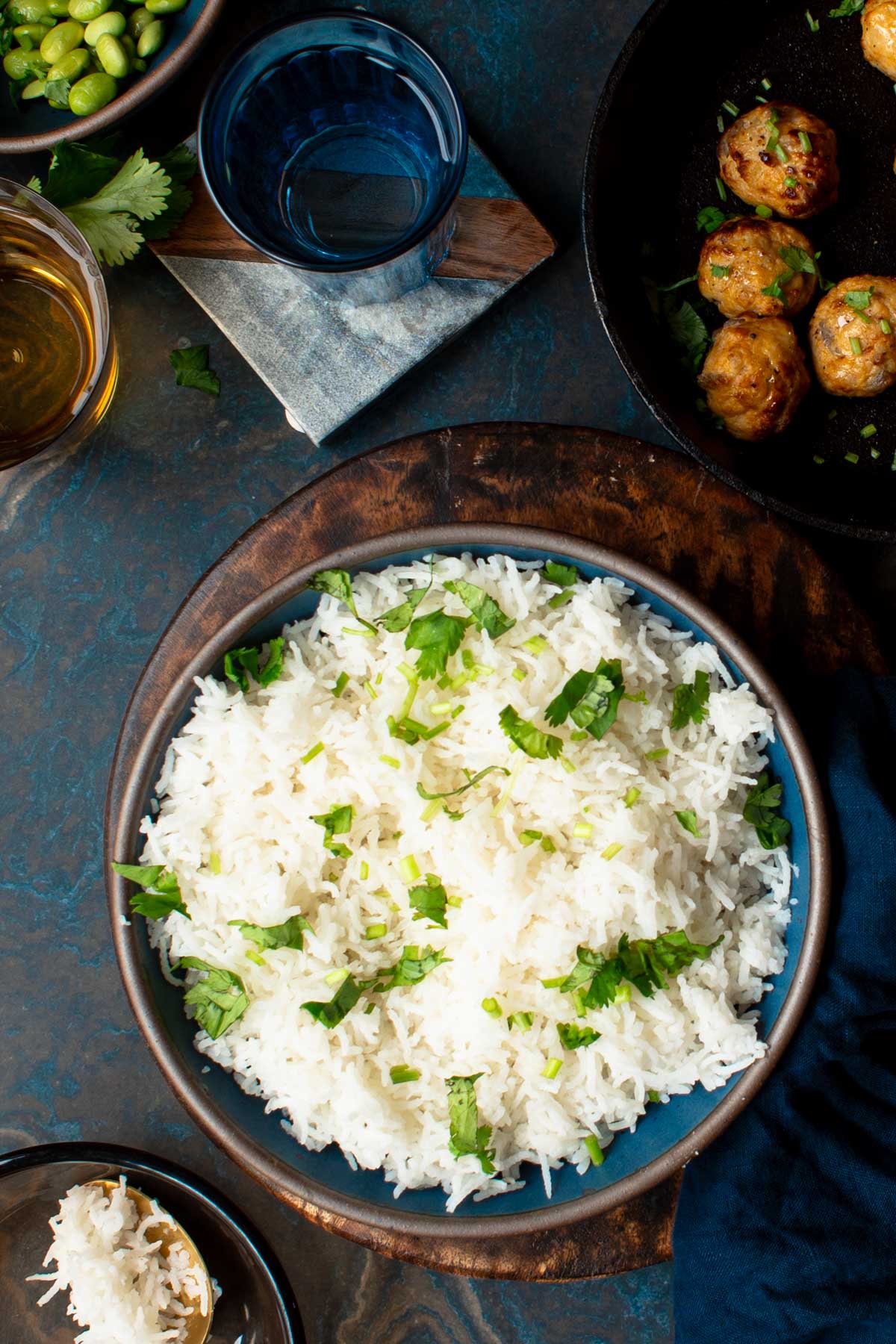
Understanding Basmati Rice
Understanding the type of rice you are working with is essential for cooking perfect basmati rice.
Basmati rice is a type of long-grain rice that's highly popular in South Asia. It has an appealing nutty, buttery taste and aroma, which comes from the presence of certain natural oils in the grain. The grains are longer and thinner than other types of rice, and they expand significantly when cooked – up to three times their original length!
Basmati rice is also low in starch, so it doesn't become gummy or sticky when cooked. When cooked, these nutrients are released from the center of the grain and allow it to remain fluffy- each grain remains separate and distinct instead of sticking together. This also helps give Basmati rice its unique flavor and aroma.
Additionally, Basmati rice cooks quickly because the grains are so thin; it's important to keep an eye on it and adjust cooking times accordingly.
Varieties of basmati rice and their flavor profiles
There are two main varieties of basmati rice - white and brown rice. White basmati rice has a light, delicate flavor and is perfect for classic Indian dishes like biryani, pulao, or jeera (cumin) rice. Brown basmati rice is more nutrient-dense than the white variety and has a nuttier flavor.
In addition to these two main varieties, there are also several specialty types such as aged basmati rice, which has an even more intense nutty flavor; Sela (parboiled) basmati rice, which is much firmer and less sticky than regular white basmati.
Each variety of basmati has its unique flavor profile, so you can choose the one that suits your tastes or recipes best.
Selecting Basmati Rice
Choosing the right quality basmati rice is key to getting perfect, fluffy results. I always look for brands that advertise aged long-grain basmati rice, as this has been stored longer and will yield better flavor and texture. I have had the best results with Dawat and Dunar brands here in the US.
Preparing Basmati Rice
To cook basmati rice perfectly, wash and rinse the rice in cold water several times until the water runs clear. This helps to remove dirt and starch, which can make your cooked rice gummy or sticky. Soaking basmati rice for 30 minutes before cooking also helps yield fluffier results. The grains will still expand when cooked, but not as dramatically as if it was not soaked.
Cooking Methods
Stovetop Method
There are a couple of ways in which you can cook the Basmati Rice on a Stovetop. In the first method , we cook the rice along with the exact amount of water needed for the rice to cook. In this method the water is absorbed into the rice grains while cooking. In the second method, we cook the rice by adding it to boiling water and straining the liquid once it has cooked through.
Stovetop Method 1
The exact rice-to-water ratio and cooking times may vary based on the type of rice you are using, so check the package instructions for exact measurements.
- For cooking long-grain white basmati rice, I usually use a 1:1.5 rice-to-water ratio (1 cup of basmati rice to 1.5 cups of water). But, if you prefer a softer texture or if you have not soaked the rice in the water ahead of time, add an extra two tablespoons of water.
- I also like to add a teaspoon of kosher salt and bay leaf to the water to enhance the flavor of the rice.
- Place the saucepan on the stovetop over medium-high heat. Bring the water to a boil.
- Once the water is boiling, add the rinsed and drained basmati rice to the saucepan. Give it a gentle stir to ensure the rice is evenly distributed.
- Reduce the heat to medium-low, cover the saucepan with a tight-fitting lid, and let the rice simmer for about 12 - 15 minutes of cooking time. Avoid removing the lid during this time to prevent steam from escaping.
- After 15 minutes, check the rice for doneness. The water should be absorbed, and the rice grains should be tender and fluffy. If the rice is still slightly undercooked, continue cooking for a few more minutes.
- Once the long-grain rice is cooked, remove the saucepan from the heat. Let the cooked basmati rice sit, covered, for 5 minutes. Then, using a fork, fluff the rice gently to separate the grains.
Stovetop Method 2 - Boiling and straining cooked basmati rice
You can also use the draining method to cook basmati rice. It’s very similar to the stovetop method, but with a few extra steps that make it even easier!
- Once the rice is done soaking, drain it in a fine-mesh sieve and set aside.
- Fill a medium saucepan with 3 cups of water for every cup of basmati rice. Add a pinch of salt to the water, then bring it to a boil over medium-high heat.
- Once boiling, add the drained basmati rice to the boiling water and give it a gentle stir. Cook the rice for 10 mins over medium heat and strain it in a colander or fine mesh strainer.
- One of the major health benefits of straining the rice after cooking is that, it helps to remove excess starch which can hurt your health. Additionally, drained rice with the excess starch removed, helps it retain its light, fluffy texture. The grains remain separate and don’t stick together or become gummy when reheated.
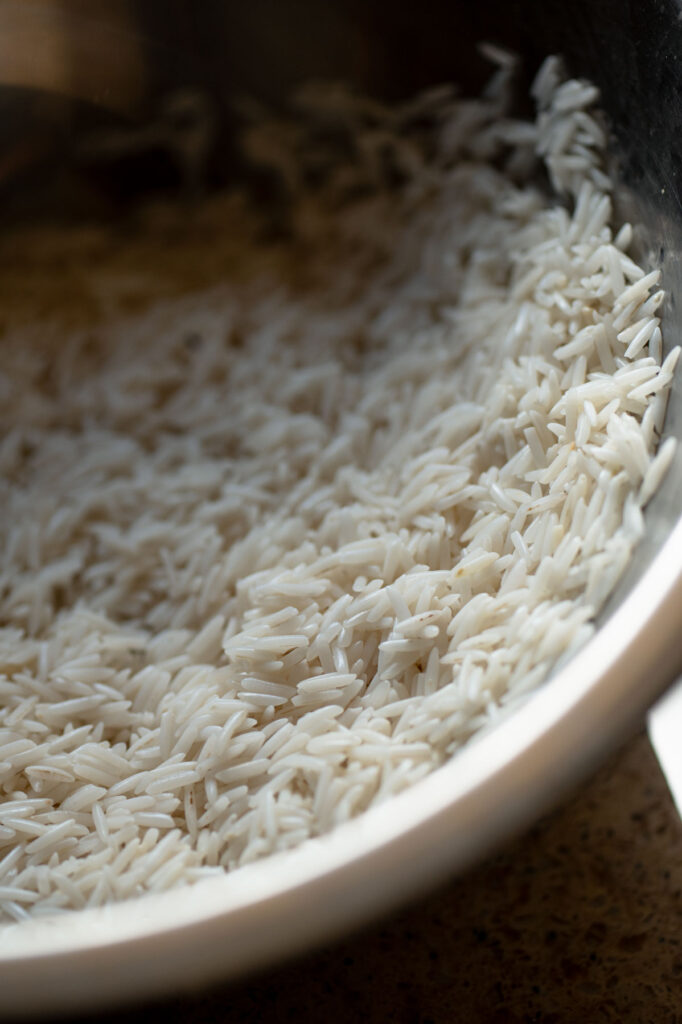
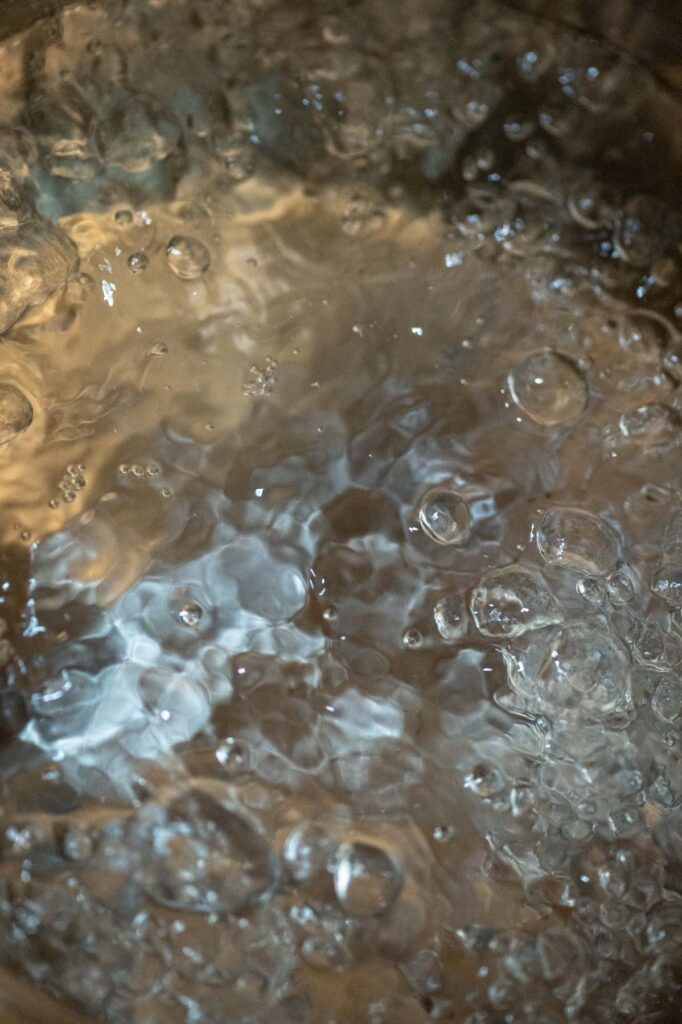
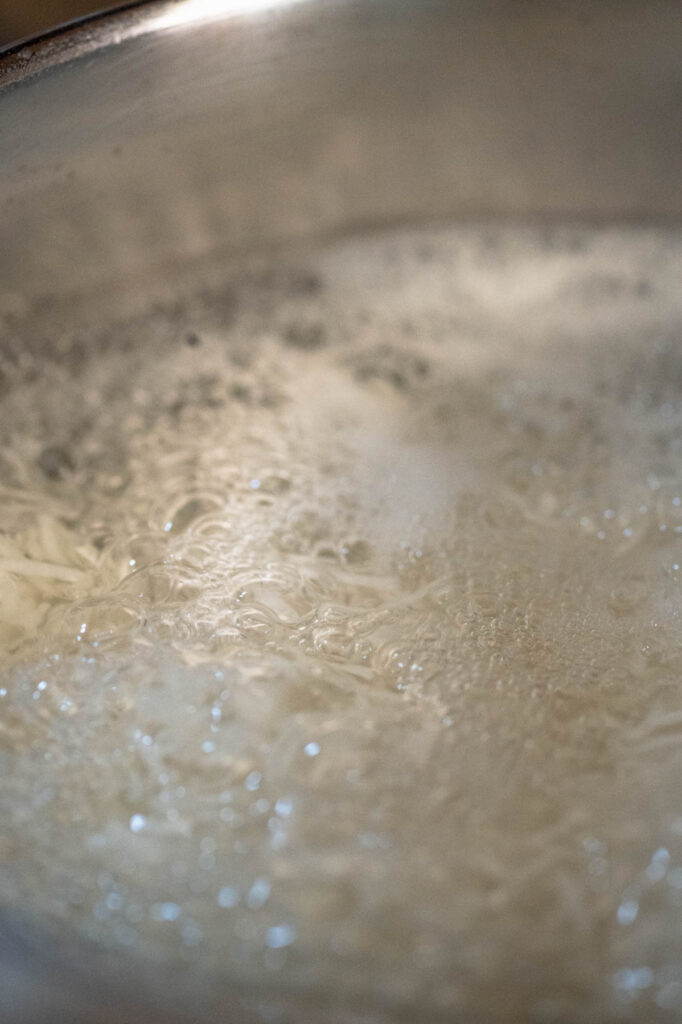
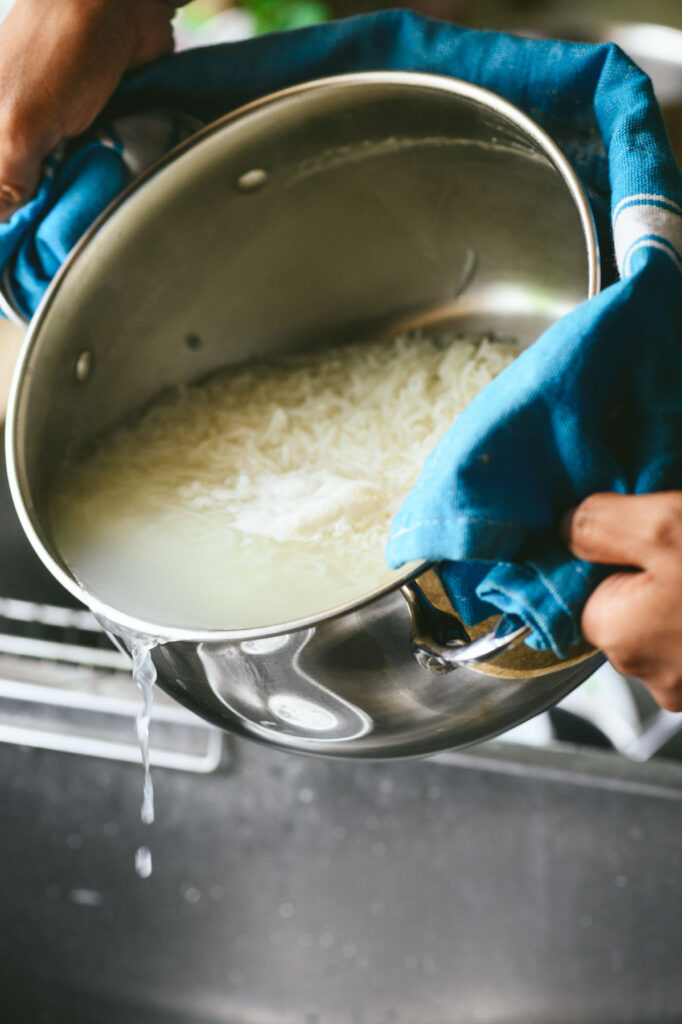
B. Rice Cooker Method
- Using a rice cooker is one of the simplest methods to make perfectly cooked basmati rice. All you need to do is add the right amount of water and hit start! Here are the steps:
- Measure out 1 cup of dry basmati rice per person and rinse it until the water runs clear. Soak the rinsed rice in cold water for 30 minutes.
- Drain the rice and add it to your rice cooker bowl. Add a teaspoon of salt, if desired.
- Use a 1:1.5 rice-to-water ratio (one cup of basmati rice and one cup of water) for best results.
- For extra flavor, add a teaspoon of ghee or olive oil and a couple of whole spices such as cardamom, cinnamon stick, or bay leaf to the water before turning on the rice cooker.
- Set your rice cooker to the white rice setting, then hit start. Once it’s done cooking, let the cooked basmati rice sit for 5 minutes and then fluff it gently with a fork for a perfectly cooked basmati rice.
C. Instant Pot Method
- 1. Measure out 1 cup of dry basmati rice per person and rinse it until the water runs clear.
- 2. Soak the rinsed rice in cold water for 30 minutes.
- 3. Drain the rice and add it to your Instant Pot bowl. Add a pinch of salt, if desired, and a teaspoon of ghee, if desired.
- 4. Use a 1:1 rice-to-water ratio (one cup of basmati rice and one cup of water) for best results.
- 5. Close the lid securely and set your Instant Pot to manual or pressure cook mode at high pressure for 3 minutes.
- 6. When cooking time is up, wait for 10 minutes of natural pressure release before opening the lid.
- 7. Once it’s done cooking, let the cooked basmati rice sit for 5 minutes and then fluff the rice with a fork for a perfectly cooked basmati rice.
Flavoring Basmati Rice
The following are some flavor variations of the basmati rice recipe
Plain Basmati Rice
Cilantro - Lime basmati rice
Cumin seeds and bay leaf-flavored basmati rice
Green Cardamom pods-flavored basmati rice
Troubleshooting Common Issues
You can address problems such as undercooked or mushy rice with the following tips:
If your basmati rice is undercooked, try adding a few extra tablespoons of boiling hot water and cooking it for an additional few minutes until the grains are tender.
If the cooked rice is mushy or sticky, this may be a sign that there was too much water in the pot while cooking. Try reducing the amount of liquid next time you cook.
Expert tips: Tips for achieving perfect fluffiness and separate grains
- If cooking on a stovetop, use a wide bottom pan when cooking as it will help the grains to absorb water and expand further.
- Stir the rice gently before covering it with a lid to ensure the rice is evenly distributed.
- Adding a teaspoon of lemon or lime juice to the cooking rice as adding a small amount of acidity to the cooking water helps break down starches and prevents the grains from sticking together.
- Let the cooked rice sit for 5 minutes after cooking, covered, then fluff with a fork. This will help separate the grains and make perfectly fluffy basmati rice.
- If possible, use a tight-fitting lid to keep the rice covered when cooking, and avoid removing the lid during this time to prevent steam from escaping.
- It also helps to add a teaspoon of ghee or olive oil to the rice and water mixture when cooking. This not only adds to the taste but also helps to make perfectly fluffy basmati rice.
Recipe Pairings and Serving Suggestions
Pairing basmati rice with different cuisines and dishes can be a delicious way to enjoy it. Here are some great serving suggestions:
- Side dishes like curry and stews.
- Pulav/ pilafs
- Rice Pudding or Kheer
- Biriyani
In addition, there are several creative ways to incorporate leftover basmati rice.
- Burritos and Tacos with an Asian twist
- Stir-fried veggies, rice, and savory sauce.
- Indo-Chinese-inspired fried rice
Storing Cooked Basmati Rice
The best way to store cooked basmati rice is in an airtight container and refrigerate it for up to a week. Also, cooked basmati rice can be frozen for up to 2 months. Place the cooled cooked rice in an airtight freezer-safe container or a resealable Ziploc bag and store it in the freezer.
I would love to hear from you! If you've tried and enjoyed our Basmati Rice recipe, please leave a review and share your experience. Your feedback matters! Don't forget to give us 5 stars if you loved it. Thank you for your support
The best way to store cooked basmati rice is in an airtight container and refrigerate it for up to a week. Also, cooked basmati rice can be frozen for up to 2 months. Place the cooled cooked rice in an airtight freezer-safe container or a resealable Ziploc bag and store it in the freezer.
1:1 and Cook on high for 3 mins with pressure release after 10 mins
1:1
1: 1.5. Cook Time - Simmer and cook for 12 to 15 mins.
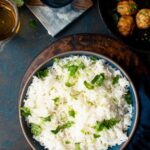
How to Cook Basmati Rice - (Perfect and Fluff)
- Total Time: 14 - 17 minw
- Yield: 4 servings
Description
Basmati rice is practically a staple in Indian cuisine; it's aromatic, fluffy, and every grain is a joy to eat. But getting it right can be tricky — if you don't get the proportions or timing just right, you can end up with an overcooked, very sticky rice mess! That's why I'm happy to share my tried-and-true method on how to cook basmati rice - perfect and fluffy every time.
Ingredients
- 1 cup (185 g) aged long grain basmati rice
- 1.5 cups water
- 1 tablespoon olive oil or ghee (optional)
- ¾-1 teaspoon kosher salt, or to taste
Instructions
- Thoroughly wash, drain and soak the basmati rice for 30 mins.
- Place the saucepan on the stovetop over medium-high heat and bring the water to boil.
- Add the soaked, drained rice to boiling water, cover and cook in simmer for 12 - 15 mins.
- The water should be absorbed, and the rice grains should be tender and fluffy. If the rice is still slightly undercooked, continue cooking for a few more minutes.
- Let the cooked rice sit covered for 5 more mins. After 5 mins, fluff the rice with a fork for a perfectly cooked basmati rice.
Notes
- If cooking on a stovetop, use a wide bottom pan when cooking as it will help the grains to absorb water and expand further.
- Adding a teaspoon of lemon or lime juice to the cooking rice as adding a small amount of acidity to the cooking water helps break down starches and prevents the grains from sticking together.
- If possible, use a tight-fitting lid to keep the rice covered when cooking, and avoid removing the lid during this time to prevent steam from escaping.
- Remember to keep the rice covered after cooking. This helps to keep the moisture and prevent it from drying out.
- Prep Time: 2 mins
- Cook Time: 12 - 15 mins
- Method: Stovetop
- Cuisine: Indian

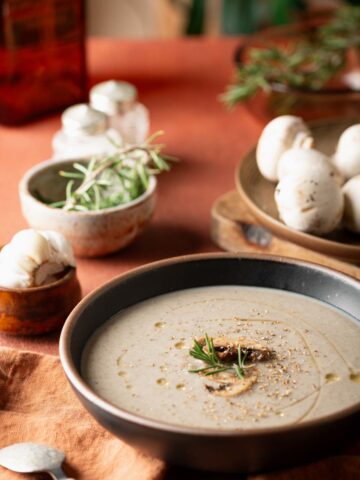
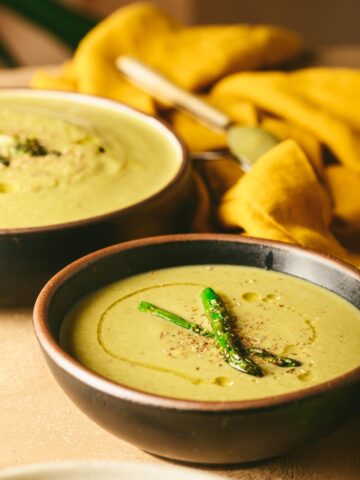
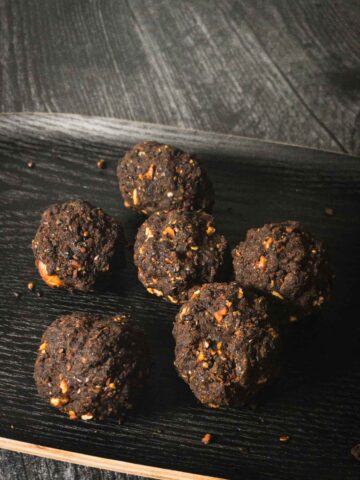
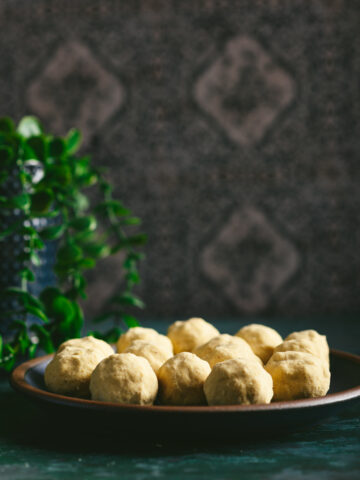
Comments
No Comments